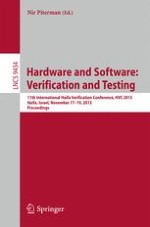2015 | Buch
Hardware and Software: Verification and Testing
11th International Haifa Verification Conference, HVC 2015, Haifa, Israel, November 17-19, 2015, Proceedings
herausgegeben von: Nir Piterman
Verlag: Springer International Publishing
Buchreihe : Lecture Notes in Computer Science
